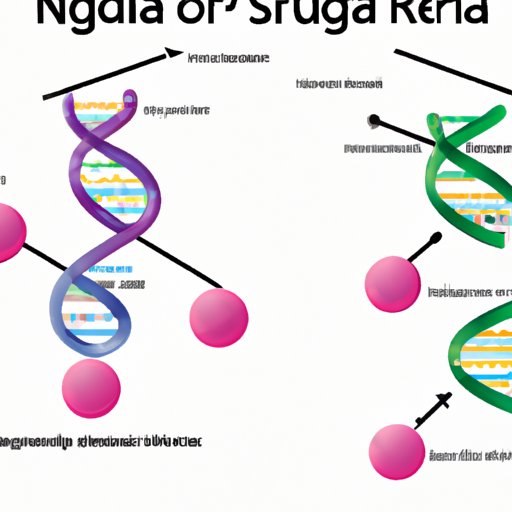I. Introduction
RNA and DNA are two of the most essential molecules that exist in living organisms. They carry genetic information that is critical for life to exist. Despite their similarities, RNA and DNA are quite distinct and serve different functions in the body. Understanding these differences is not only important for biologists, but it can also help laypeople gain a better understanding of the complexity of living organisms.
II. Structure
One of the most apparent differences between RNA and DNA is their structure. DNA is double-stranded, meaning it consists of two strands of nucleotides that are twisted together in a double helix. RNA, on the other hand, is single-stranded, which means that it only contains a single chain of nucleotides.
The single-stranded nature of RNA means that it can adopt a wider variety of folded structures than DNA. In fact, RNA is capable of folding back on itself to create loops and other intricate structures that provide special abilities to the molecule.
III. Nitrogenous bases
Another critical difference between RNA and DNA is the type of nitrogenous bases they contain. Nitrogenous bases are the building blocks of both RNA and DNA, but the two molecules differ in the types of bases they contain. DNA contains four nitrogenous bases: adenine (A), guanine (G), cytosine (C), and thymine (T), while RNA only contains three of these bases: adenine, guanine, and cytosine. Instead of thymine, RNA contains a base called uracil (U).
The presence of uracil in RNA instead of thymine is a significant difference that affects how the molecule interacts with other molecules in the body.
IV. Sugar molecule
The sugar molecule that is found in RNA and DNA is also different. RNA contains a sugar molecule called ribose, while DNA contains a sugar molecule called deoxyribose. The difference between these two molecules is relatively minor, with the only significant distinction being that deoxyribose lacks one oxygen atom compared to ribose. However, this difference affects how the two molecules function in the body.
V. Stability
One of the reasons why RNA and DNA serve different functions is their stability. DNA is incredibly stable and is capable of being replicated with relatively few transcription errors. RNA, on the other hand, is relatively unstable and is prone to degradation.
The unstable nature of RNA is a critical aspect of its function. Since RNA is only meant to serve as an intermediary between DNA and the various proteins that the body produces, RNA’s instability allows it to act quickly and be rapidly degraded once it has fulfilled its function.
VI. Function
The primary function of DNA is to act as a stable storage for genetic information. It serves as a template for the creation of RNA, which is essential for the expression of genes. RNA, on the other hand, serves as a messenger between DNA and the ribosomes, which are the protein synthesizing machines in the cell.
RNA’s function as an intermediary in the process of gene expression is essential for the body to operate correctly. Without RNA, it would be impossible for the genetic information stored in DNA to create the proteins needed to keep the body functioning.
VII. Conclusion
The differences between RNA and DNA may seem trivial, but they have significant implications for the function of the molecules in the body. Understanding these differences can help us gain a better understanding of the complexity of life on a molecular level. By understanding the structures, nitrogenous bases, sugar molecules, stability, and functions of RNA and DNA, we can appreciate fully how our genetic material works.
